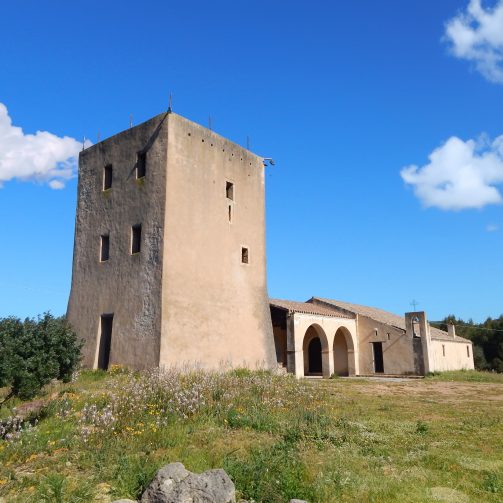The church stands on a site a few kilometers from the town, of great historical interest, where there are the remains of earlier human settlements, ranging from the Nuragic to the Byzantine period. The place is of special historical importance especially because there are traces of the ancient medieval village of Teulat, already mentioned in documents from 1355 and abandoned completely at the end of the 16th century, only to be later rebuilt, under the name Teulada, in its present location.
It is a simple building with a single nave. The roof is gabled and is woven on three full arches, perpendicular to the axis according to a scheme that is still Gothic in its compositional conception. Attached to either side are two bodies of buildings, one of which serves as the sacristy, while the other houses the priors, who annually organize the two festivals in honor of the saint: the first, propitiatory of abundant harvests and crops; the second, of thanksgiving for grace received, until a few years ago took place in September, now for reasons outside the religious, it is brought forward to the middle of August.
A simple arched doorway opens on the very poor elevation, topped by a circular eye. The roof pitches also extend over the side bodies. To the right, a small bell gable is perhaps the only sign from which to infer that it is a church.
Next to the small church and united to it through an open loggia, formed by four arches set on pillars, stands the tower of the same name, in a very atmospheric setting overlooking the valley below, all the way to the sea.
The tower of St. Isidore dates to the early 1600s and can be traced back to the defensive policy of Philip II’s 1587 prammatica on the construction of coastal towers to protect fishing and trade, agriculture, pastures and hygiene. Ours, however, has a square floor plan and two floors without a terrace, with basement and a cordon-less escarpment. It was more precisely a house-fort, which had no other function than as a shelter to protect against sudden and temporary invasions by Barbary pirates. It had, in addition, alarm functions on the Teulada road and, as a day and night broadcasting center, visual signaling, with smoke and lights, and acoustic with the sound of the horn or colo thundering of a culverin: all regulated and agreed upon. Depending on the situation, people would flee or take up arms. The culverin was, until the early decades of the twentieth century, abandoned in the carriage house of the baronial palace.
Near the tower of St. Isidore, a fierce battle was fought on September 15, 1628, the outcome of which was favorable to the Teuladini.
Says the chronicle, “The barbarians, many in number and ferocity, clashed with the Teuladines and of them experienced what strength was in those few. At last it happened that the enemies desisted and retreated, pursued in precipitate flight. Large numbers perished by the pond, the harbor and the sea.”
Baronial property, the tower was and was active until 1867, when the fate of all coastal towers was fulfilled. Before and after this year a hermit, sacristan and guardian of the adjoining church, stayed there. A cabro, or registry of administration, records that St. Isidore had his own chest with three keys and that a sum was drawn from this chest to purchase a horse and much tobacco for the holy man.









